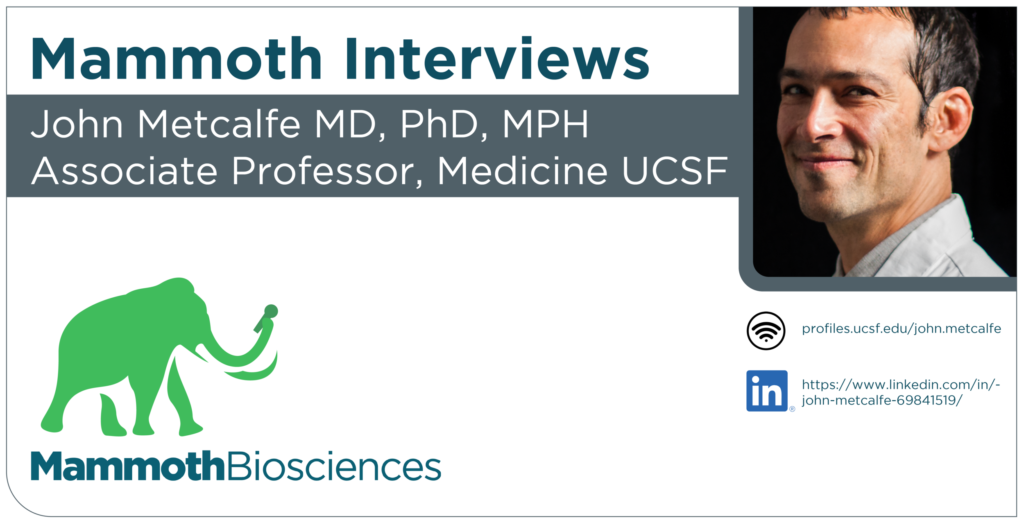Tyler Ford
12/11/2019
We regularly invite scientists to present their research to the Mammoth team. This facilitates collaborations and expands our knowledge of important topics in the worlds of CRISPR, genome editing, diagnostics, and more. Rather than keep what we learn to ourselves, we’ve decided to share it with you through our Mammoth interviews series. This series features short Q&As with the many interesting scientists who speak at Mammoth. Get ready for some fascinating science and even more fascinating people!
In this post, we feature Professor John Metcalfe from UCSF.

What are your research interests?
My academic research focuses on global human health—in particular around tuberculosis diagnosis, treatment, and sequelae in Southern Africa.
What drives your work?
Broadly, the idea that in the 21st century, no matter where or into what circumstances we are born, we are truly all here together. Poor health continues to exact an enormous toll in low- and middle-income countries, often for reasons that should be easily preventable or treatable. Lack of well-being seriously impacts our collective responsibility as stewards of this planet and as mindful, conscious decision-makers. Leveling the playing field with respect to health would contribute to leveling it in other crucial ways as well.
How does your role as an MD shape your research?
I come from humble beginnings. Although being a good doctor certainly has a lot to do with excellence—scholarship, hard work, and (in the academic setting) teaching—in my view the best doctors have at their core an inescapable empathy and humility. We are witness to great storms of illness: things that blindside you, change all of your plans, and fray your social fabric. As doctors, we can often only re-direct this great power and not reverse it. So while this is a lifelong practice, recognition of our inherent frailties, the precipice of time, and seeing firsthand the real difference good medical care can make is extremely grounding. Approaching our work from this grounded place forms the basis of our research.
Why is tuberculosis a particularly important infectious disease to work on?
M. tuberculosis kills more people today than any other single microbe and causes a tremendous amount of suffering and loss of quality of life even when treated successfully. Tuberculosis is also a measure of social and economic well-being, and in this way is a litmus test for how we’re doing as a larger community. Losing a loved one to a curable respiratory infection that we’ve known how to treat for decades at very limited cost amplifies the tragedy. Of course, people with tuberculosis often could use a lot more in addition to treatment—like a responsible political system, education, a living wage, etc. The role of the academic establishment in recognizing and calling attention to social disparities has not been very clear, at least not in my time. Hopefully, by bringing attention to tuberculosis, we will also bring attention to the social disparities as well.
What are the key roadblocks to effective TB treatment?
Prevention of course is better than cure, and some exciting work is taking place in the M. tuberculosis vaccine space. However, gains are hard fought, and clinical trials are slow and expensive.
In terms of treating the patient in front of you, a conventional pneumonia can be treated with a single antibiotic taken once daily for 5–7 days. In contrast, treating tuberculosis requires up to 4 or 5 sizable pills per day for 6 months. The reasons for this need for longer therapy are still surprisingly poorly understood but are likely related to the ability of the microbe to alter its metabolic state (and thereby its susceptibility to antibiotics) in the face of stressors. Genetic resistance to drugs ups the ante in a major way, lengthening treatment further, requiring antibiotics with more toxicities, and often again failing.
Finally, developing entirely new regimens is challenging due to the length and cost of treatment trials, the lack of accurate surrogates of treatment response, and the perception of limited profit return relative to other diseases.
What’s CRISPR’s role in TB research and clinical advancement?
The full scope of what CRISPR has to offer TB research and clinical practice is a rapidly evolving concept. From the diagnostic perspective, the potential to circumvent PCR [polymerase chain reaction] amplification; for testing non-sputum-based samples—including cell-free DNA; for unprecedented sensitivity; and for rapid RNA detection (e.g., to distinguish active from old disease) are extremely exciting. Developing this potential for an M.tb-specific Cas system on a point-of-care-friendly platform could be clinically transformative. Beyond diagnostics, CRISPR-based genetic manipulation offers an entirely new window on fundamental biological questions, including the pathobiology of M. tuberculosis–human immune system interaction, which is fascinating—but here I’m getting in over my head. Bottom line: it is a very exciting time to be thinking about TB-CRISPR.
